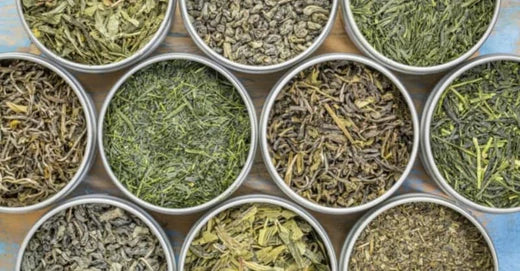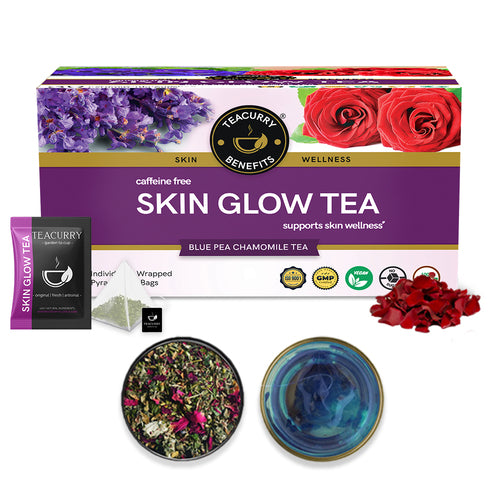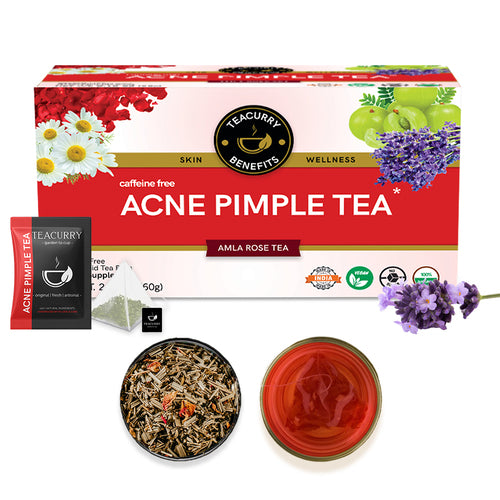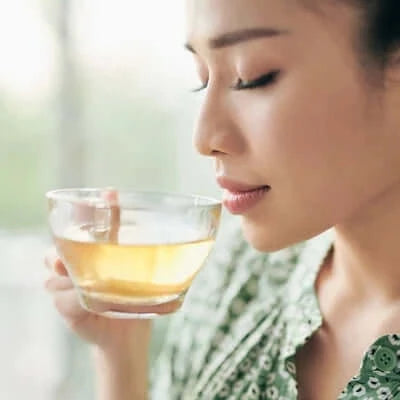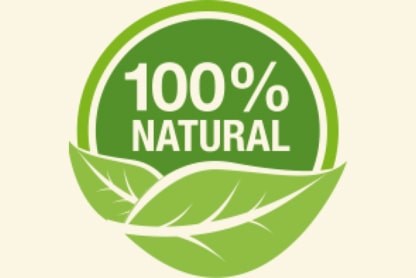The green tint of the brew and the natural green colour of the leaf is what gives Green tea its name. Green tea produces each year varies based on the region they are grown and also based on seasonality (usually around early to mid-spring and the order of the flush). Moreover, the differences become more striking based on the way the harvesting is done and the method used for processing the tea. (Reference: Green Tea: Health Benefits Uses and Side Effects, RX List, Retrieved 1 January 2024) Harvests vary based on the grinding process, the rolling method and the length and type of dying process.
Table of Content.
1. What is The Green tea origins
3.1 Chinese Green Teas—Pan Fired
3.2 Japanese Green Teas—Steamed
3.3 Caffeine content in green tea
5. What are the different types of Green Tea
5.1 Sencha Green Tea
5.4 Tencha Green Tea
5.5 Matcha Green Tea
5.7 Konacha or Agari Green Tea
5.9 Fukamushi cha (Fukamushi Sencha or Fukamushi Ryokucha) Green Tea
5.10 Kamairicha Green Tea
5.11 Genmaicha Green Tea
5.12 Bancha Green Tea
1. What is The Green tea origins
While all green tea originates from the same plant species, there are different types of green tea grown and produced all over the world today, including China, Japan, India, Sri Lanka, Taiwan, Bangladesh, New Zealand, Hawaii and even South Carolina. Green tea, however, is considered to have originated in China. It is said that even today the word “tea” in China refers only to green tea, not to the general category of tea as it does in the West. China’s Yunnan province is considered to be the original home of the Camellia sinensis plant species. In fact, 260 of the world’s 380+ varieties of tea can be found in Yunnan. One popular legend suggests that Shennong, Emporor of China and supposed inventor of Chinese medicine, discovered tea as a beverage around 2737 BC when fresh tea leaves from a nearby tea tree fell into his cup of just boiled water. Others credit various Buddhists in the 500s BC and subsequent centuries for the discovery of tea. Buddhists would travel between India and China spreading their religion, culture and ritual of tea. Buddhist monks grew, harvested and produced tea much like their Catholic counterparts in European monasteries did with grapes and wine.
The monks’ habit of tea drinking for physical refreshment, to aid meditation and as a substitute for alcohol developed into a spiritual and social practice that spread across China. Green tea is claimed to have been popularized in Japan around 1190, when a Zen priest visiting and studying in China’s great Buddhist monasteries and temples returned to Japan with tea plant seeds and bushes. The young priest, called Eisai, used his experience growing and drinking tea in China to popularize the way of tea as a meditation ritual within his own community of Buddhist monks, eventually spreading the custom of tea drinking throughout the rest of Japan. To this day, China and Japan are the top two green tea producing and exporting countries in the world.
2. Green tea processing
For green tea, the tea leaves are harvested from the Camellia sinensis plant and are then quickly heated—by pan firing or steaming—and dried to prevent too much oxidation from occurring that would turn the green leaves brown and alter their fresh-picked flavor. A brewed green tea is typically green, yellow or light brown in color, and its flavor profile can range from grass-like and toasted (pan fired) to vegetal, sweet and seaweed-like (steamed). If brewed correctly, most green tea should be quite light in color and only mildly astringent. By contrast, black tea leaves are harvested and allowed to fully oxidize before they are heat-processed and dried. During oxidation.
oxygen interacts with the tea plant’s cell walls, turning the leaves the rich dark brown to black color that black tea is famous for, and significantly altering their flavor profile. A brewed black tea can range in color from amber to red to dark brown, and its flavor profile can be anywhere from malty to fruity to roasted, depending on how it was processed. Black tea typically has more astringency and bitterness, but if brewed correctly it should be smooth and flavorful.
3. Types of green tea
As you’ve no doubt noticed if you’ve sipped on several different types of green tea, not all green tea taste the same, even though it all comes from the same plant variety. It depends not only on the processing method the tea producers use, but also on the cultivation practices the tea growers use. What time of year is the tea plucked? How is the plant pruned? What parts of the plant are plucked? Are the plants treated with chemicals or are they organically grown? What kind of heat is applied to the tea leaves to stop oxidation? How are the tea leaves shaped, rolled and dried? Are the leaves left whole or cut in smaller pieces? A tea’s final flavor also depends on the “terroir” or environment the tea is grown in.
Is it cool and mountainous or hot and tropical? Do the plants live next to limestone and pine trees or sand and seaweed? Do the tea plants grow near other crops that can affect their flavor, like rose bushes, coffee plants or grape vines? The most popular, widely consumed types of green teas hail from the places where green tea originated: China and Japan. Green teas from China and Japan have different flavor profiles based on where and how they are grown, but most distinctively how they are processed—pan fired in China and steamed in Japan. Other countries producing green tea typically take cues from China or Japan and adopt one of these country’s tea production styles.
3.1 Chinese Green Teas—Pan Fired
The Chinese style of green tea is characterized by pan firing, where tea leaves are heated in a basket, pan or mechanized rotating drum to halt the oxidation process. Chinese green teas may be fired more than once during processing, depending on the style of tea being produced. These firings may take place in wicker baskets, steel wok-like pans, metal drums or other containers over charcoal, gas flame, electric heat or hot air, depending on the final flavor outcome desired. The flavor can be altered greatly depending on the number and type of firings, but generally a pan fired Chinese green tea takes on a yellowish-green or dark green color and impart a grassy, earthy, roasted flavor.
Some popular pan fired Chinese green teas include:
- Dragonwell: A smooth, flat, sword-shaped appearance and pan-fired toasty taste give this tea its characteristic look and flavor no other green tea-producing region has been able to duplicate. It is considered a classic pan-fired Chinese green tea.
- Gunpowder: Fired in perforated metal tumbler that tosses the leaves around in a figure eight pattern Gunpowder tea takes is name from the pellet-like shape of the finished leaf.
3.2 Japanese Green Teas—Steamed
The Japanese style of green tea is characterized by steaming, where tea leaves are treated briefly with steam heat within hours of plucking to both halt the oxidation process and bring out the rich green color of both the tea leaves and the final brewed tea. The steaming process creates a unique flavor profile that can be described as sweet, vegetal or seaweed-like. Some Japanese green tea may also be shade grown during cultivation or roasted during processing, both to create additional flavor characteristics.
Some popular Japanese green teas include:
- Sencha: Sencha makes up more than 80 percent of the tea produced in Japan and is the most popular tea drunk in households and restaurants throughout the country. It is made from tea leaves that are steamed then typically rolled into long, skinny strands.
- Hojicha: Sencha is roasted over high heat to produce Hojicha, a tea with a roasted, nutty flavor. The application of high heat also helps reduce the tea’s caffeine content.
- Genmaicha: A blend of Sencha and roasted and popped rice, Genmaicha is a toasty tasting treat that is a popular tea to serve with food.
- Gyokoro: The tea leaves are shaded during the last few weeks before plucking to intensify the color and flavor of the tea that will become Gyokoro. During processing, it is rolled into its characteristic thin needlelike shape. Gyokoro is considered to be Japan’s most treasured tea.
- Matcha: Shade-grown like Gyokoro, the tea leaves that make Matcha are ground into a powder instead of shaped and rolled. Matcha is key to Japanese tea ceremonies and has become a very popular ingredient for cooking.
3.3 Caffeine content in green tea
Green tea is generally known to have lower caffeine content per cup than black tea and much lower caffeine content than coffee. Like all drinks cultivated from caffeinated plants, however, a specific level of caffeine per cup of green tea is hard to define as it will depend on the type of green tea as well as how is was processed and prepared.
According to a Journal of Food Science test of caffeine levels across commercial brands of green tea, the caffeine content in each 8 oz. cup varied by brand from 11 mg to 47 mg, and other sources record green teas that can contain upwards of 60 mg per brewed cup.If you’re looking for low caffeine content in your green tea, be sure and read the packaging carefully or ask your tea supplier directly for the caffeine information specific to the tea you are buying.
4. Tasting green tea
As we’ve demonstrated, green tea can hail from many different parts of the world and processed using one of many different methods. So how the green tea you’re brewing tastes will depend on many factors, including where it was grown, how it was processed and even how it was brewed. However, there are some common traits used to describe the overall flavor profile of the green tea category, including vegetal, grassy, earthy, sweet, buttery, nutty, toasty, seaweed-like, broth-y, lush, green and herbaceous.
Teatulia®’s green tea hails from our own USDA-certified organic garden in Bangladesh. We use the steaming method to process our green tea, so the tea stays bright green and fresh and has a grassy, vegetal flavor. To get a better idea of the flavor profile of Teatulia’s green tea, visit our green tea product page.
5. What are the different types of Green Tea
Green tea leaves are picked and are immediately followed by the steaming and roasting process to prevent the oxidation process from occurring and stopping any fermentation to happen. (Reference: Health Benefits of Tea, WebMD, Retrieved 1 January 2024) Different types of this step lead to different types of Tea, especially Green Tea. For example, the Japanese and Chinese green tea leaves differ in the steaming process as Chinese farmers pan-fry the leaves to flatten and dry out the leaves immediately after picking. (Reference: Flavonoids: The secret to health benefits of drinking black and green tea?, Harvard Health Publication, Retrieved 1 January 2024) On the other hand, the Japanese farmers steam fry the leaves. Pan-frying also makes the leaves stiffer. (Reference: 10 Different Types of Green Tea, Big Flag Tea, Retrieved 1 January 2024)
Fact: In the United States subcontinent, the Teacurry Green Tea are one of the most famous brands in terms of Green Tea. Teacurry green tea varies from $17.99 for a 30 tea Bags . (Prices as viewed on 1 January 2024)
5.1 Sencha Green Tea
- Appearance & Color of the leaves - Leaves acquires a needle-like shape because of the rolling process. Leaves are dark bright green in colour.
- Tea Liquor Color - Transparent yellow to light yellow-green
- Aroma - Fresh and soothing - Sencha green tea leaves have a refreshing flavour that can be described as vegetal, green, seaweedy, or grassy.
- Taste & Flavor - Good balance between astringent and sweet - Sencha green tea acquires an intensified flavour compared to other green tea varieties because of the rolling process. The rolling process leads to the release of all the juices inside of the leaves.
- Aftertaste - Deep, long-lasting green
- Water temperature - 70°C (158°F)
- Growing Method - Sencha is grown in direct sunlight.
- Timing of Harvest - Sencha is usually harvested as part of the first flush.
- Processing Method - Once picked, the tea leaves are steamed. The steaming process is done with the youngest leaves at the top. After the steaming process, the leaves are dried and rolled. The processing method plays a critical role in the price of green tea in the form of green tea bags or loose green tea leaves
- Health Benefits - Sencha tea is one of the highest sources of Vitamin C. In humans, Vitamin C helps in fighting the common cold and in boosting the immune system.
- Uniqueness - Sencha is the most frequently drunk variety of green tea leaves around the globe. (Reference: Varieties of Green Tea, ITO EN Ltd, Retrieved on 1 January 2024)

Sencha Green Tea, licensed under CC BY 2.0
5.2 Hojicha Green Tea
- Appearance & Color of the leaves - The leaves look much darker than Sencha because of the roasting process.
- Tea Liquor Color - Bright, transparent brown
- Aroma - Deep roasted aroma - Hojicha is less bitter in taste than Sencha.
- Taste & Flavor - Light and uncomplicated - Hojicha has a savoury aroma to its leaves because of the roasting process.
- Aftertaste - Subtle green tea
- Water temperature - 95°C (203°F)
- Processing Method - Hojicha is prepared from Sencha by the roasting process. At 200 degree celsius, the Sencha green tea leaves are roasted in a roasting pan. Caffeine is sublimated during this process and Hojcha is formed.
- Health Benefits - Helps in increasing the bodies immune system and assists in fighting the common cold.
- Uniqueness - Among the different types of tea, its leaves have a distinct roasted aroma. (Reference: 10 different types of green tea you need to know about, Big Flag Tea, Retrieved on 1 January 2024)
Hojicha Green Tea, licensed under CC BY 2.0
5.3 Gyokuro Green Tea
- Appearance & Color of the leaves - The leaves are of darker shade compared to Sencha but have lower astringency and has a rich flavour. Leaves are less spread out and not in needle shape, unlike Sencha.
- Tea Liquor Color - Pale, transparent yellow
- Aroma - “Sea breeze” aroma - The aroma is similar to nori seaweed.
- Taste & Flavor - Sweet with a deep umami flavour - Gyokuro is known for its sweet flavour. The sweet flavour is because of the presence of high levels of theanine. Theanine is an amino acid that forms because of the shading process of the leaves.
- Aftertaste - Seaweed, spinach
- Water temperature - 40°C (104°F)
- Growing Method - Gyokuro tea bushes are shaded with cloth or reed screen around three weeks prior to picking. Because of restricted sunlight, the generation of catechins from amino acids (theanine) is suppressed.
- Timing of Harvest - Its harvested as part of first or second flush, however in its case shading the tea leaves from the sunlight becomes an utmost requirement.
- Processing Method - Post harvesting the tea leaves are taken through the same steaming and rolling process as Sencha.
- Health Benefits - Gyokuro contains large amounts of caffeine and chlorophyll as compared to the types of tea. Both these components stimulate the brain and nervous system. It also assists well as a skin ointment and helps in tissue growth.
- Uniqueness - Since the tea is more difficult to shade and cultivate, the production cost and price of green tea leaves are high. (Reference: Best Green Tea Types for Beginners, The Spruce Eats, Retrieved on 1 January 2024)
Gyokuro Green Tea, licensed under CC BY 2.0
5.4 Tencha Green Tea
- Appearance & Color of the leaves - During the process of preparing Tencha, vines and stems are removed and only the leaves are left behind. Leaves are bright green in colour and lack the blacks because Tencha tea does not undergo any rolling process.
- Tea Liquor Color - Pale green
- Aroma - Subtle noble Aroma
- Taste & Flavor - The taste is deep and mellow because of the high mineral content. Aftertaste - Mellow sweet
- Water temperature - 40°C (104°F)
- Processing Method - Similar to Gyokuro, the raw leaves (Ichibancha) are grown according to the covered culture method to block out most sunlight. The coverage period is longer than the standard 20 days that Gyokuro is covered for. After steaming, the leaves are dried without being rolled. This step has huge impact determine the price of green tea leaves from the different types of tea.
- Health Benefits - As Tencha doesn’t undergo the rolling process so larger leaves release high levels of minerals and vitamins and so it acts as a booster in terms of energy and metabolism. The high level of caffeine allows for the alertness of mind. this is one of the reasons that the price of green tea of this variety is on the higher side.
- Uniqueness - This tea is best before and after exercise to rejuvenate the body. (Reference: Japanese Green Tea: Satisfy Your Senses With 10 Shades Of Green, Sazen Tea, Retrieved on 1 January 2024)
Tencha Green Tea, licensed under CC BY 2.0
5.5 Matcha Green Tea
- Appearance & Color of Matcha - Matcha is the powdered form of Tencha. The powder is bright green in colour.
- Tea Liquor Color - Matcha green tea is vivid green in colour
- Aroma - Matcha green tea has a refreshing aroma of fresh green leaves - Being another form of Tencha it smells exactly the same - having a subtle noble aroma. This green tea leaves is one of the most famous among the different types of tea.
- Taste & Flavor - Rich and complex with a deep umami flavour - Matcha tea is also used to prepare traditional Japanese confections and savoury dishes, because of its sweeter taste.
- Aftertaste - Matcha green tea has a sweet aftertaste.
- Water temperature - 80°C (176°F)
- Processing Method - Matcha tea is the stone grounded form of Tencha. After the shading, harvesting, and steaming, the leaves are then air-dried, removed of stems and veins, and then ground into a powder to be brewed as Matcha Green Tea. This is the reason why there is huge range of price of green tea available in the market.
- Health Benefits - Matcha tea is a source of a high amount of natural nutrients and so it is very helpful in rejuvenating healthy skin and in cleaning the body.
- Uniqueness - Dark Matcha tea also known as Koicha was previously made from the leaves of very old tea bushes - over 100 years old. In recent times, cultivar varieties suited to Koicha have been selected to produce them in a much shorter time period especially in Japan.
Sencha Green Tea and Matcha Green Tea, Tea Forte, Google Images, licensed under CC BY 2.0
5.6 Funmatsucha Green Tea
- Appearance & Color of the leaves - Funmate Sucha has a much darker colour compared to Gyokuro. It's in a powdered form like Matcha, however, it lacks the bright green colour.
- Tea Liquor Color - Earthy green
- Aroma - Very earthy smell
- Taste & Flavor - Funmatsucha has a very bitter taste because the leaves during the processing period do not get shaded from the sunlight and therefore enduring more photosynthesis. Funmatsucha tastes like a concentrated sencha, quite astringent and bitter.
- Aftertaste - Deep but a but bitter Water temperature - 80°C (176°F)
- Processing Method - Funmatsucha consists of green tea leaves ground into a powder. These aren’t high-quality leaves, which is reflected by the price of green tea too.
- Health Benefits - Funmatsucha has a much higher amount of antioxidants compared to other green teas and because of high antioxidants its a perfect tea choice to fight against the common cold, headaches, and illnesses.
- Uniqueness - Funmatsucha is known for its cheap price of green tea leaves and bitter flavour. (Reference: Funmatsucha, My Japanese Green Tea, Retrieved on 1 January 2024)
Funmatsucha Green Tea, licensed under CC BY 2.0
5.7 Konacha or Agari Green Tea
- Appearance & Color of the leaves - Konacha is bits of filtered out buds from Gyokuro and Sencha. So they are bulkier compared to other teas.
- Tea Liquor Color - Deep dark green, opaque
- Aroma - Deep earthy aroma
- Taste & Flavor - Bitter and astringent flavours
- Aftertaste - Raw and spicy green
- Water temperature - 75°C (167°F)
- Processing Method - Konacha comprises of small bits of leaves that are filtered out of the process of Gyokuro or SenchaIt. On further roasting of Konacha, one can prepare Houjikonacha, diluting the bitterness and obtaining a more deep flavour.
- Health Benefits - Konacha can help in fighting diabetes and heart diseases because of its high catechin content.
- Uniqueness - Konacha means powder tea, but Konacha is leaves and not powder.
Konacha Green Tea, licensed under CC BY 2.0
5.8 Kabusecha Green Tea
- Appearance & Color of the leaves - Kabusecha Green Tea consists of dark green coloured, full-bodied leaves.
- Tea Liquor Color - Yellow-green
- Aroma - Soothing
- Taste & Flavor - Mild with a moderate umami flavour
- Aftertaste - sweet and refreshing
- Water temperature - 60°C (122°F)
- Growing Method - Kabusecha is produced through the cover culture but Kabusecha is covered for only 7 days, unlike Gyokuro. Straw blankets are used for covering.
- Processing Method - Covering culture enables new leaf shoots to acquire a darker green colour, full-bodied flavour and lower astringency than Sencha.
- Health Benefits - Help to relieve anxiety and stress, lower cholesterol, improve digestion and even help to improve dental health.
- Uniqueness - Kabusecha Green Tea Leaves is usually referred to as a hybrid of sencha (soothing aroma and astringency) and Gyokuro (umami flavour) giving it uniqueness among various types of tea.
Kabusecha Green Tea, licensed under CC BY 2.0
5.9 Fukamushi cha (Fukamushi Sencha or Fukamushi Ryokucha) Green Tea
- Appearance & Color of the leaves - Also because of the longer steamed process the tea becomes finer and the tea made from these leaves have a much higher leaf content and very green in colour.
- Tea Liquor Color - Green yellow
- Aroma - This process provides a richer flavour compared to Sencha, due to the removal of moisture and oxidation. Taste & Flavor - Less astringent than sencha, mild and mellow taste
- Aftertaste - Long-lasting mellow green
- Water temperature - 70°C (158°F)
- Processing Method - Fukamushi means "steamed for a long time." Fukamushicha contains leaves from the Sencha, Gyokuro, Kabusecha, and Bancha. The additional process is that of deep steaming for three-four times longer providing the leaves with a deeper colour and brew.
- Health Benefits - It has soothing effects on the stomach due to its light flavour. Moreover, the active components of the tea are easily absorbed into the body even though they do not dissolve in water.
- Uniqueness - As the leaves have been thoroughly steamed, so Fukamushicha Green Tea leaves become a bit powdery and the tea takes on a stronger taste and darker green colour.
Fukamushicha Green Tea, licensed under CC BY 2.0
Kukicha Green Tea, licensed under CC BY 2.0
5.10 Kamairicha Green Tea
- Appearance & Color of the leaves - Much darker in colour because of the hot frying process.
- Tea Liquor Color - Clear, pale yellow
- Aroma - Distinctly deep aroma of a roasting kettle Taste & Flavor - Uncomplicated
- Aftertaste - Roasted almond with a hint of cocoa
- Water temperature - 85°C (185°F)
- Processing Method - Kamairicha doesn't go through the roasting process instead leaves of Kamairicha are fried in a hot pan at 300°C (572°F) to halt oxidation, continuously tossed in a process called Iriha-ki.
- Health Benefits - Kamairicha Green Tea Leaves is found to be very effective against heart problems and against cholesterol.
- Uniqueness - This process of a hot friend and testing of tea is very rare even in Japan and Kamairicha only consists of 2% of all green tea produced, making every cup a precious luxury.
Kamairicha Green Tea, licensed under CC BY 2.0
5.11 Genmaicha Green Tea
- Appearance & Color of the leaves - In case of Genmaicha, the brown rice provides a grainier touch and flavour to Sencha leaves.
- Tea Liquor Color - Pale yellow-green
- Aroma - Deep aroma of roasted brown rice
- Taste & Flavor - Refreshing - One can taste the combination of the savoriness of roasted brown rice and the refreshing flavour of Sencha.
- Aftertaste - Pleasant roasted
- Water temperature - 85°C (185°F)
- Processing Method - Genmaicha Green Tea is produced by mixing Bancha or medium grade Secha with brown rice in equal proportions. The brown rice before mixing is soaked, steamed, roasted and popped.
- Health Benefits - Genmaicha is very much used by children and elderly people because of its low caffeine content. It also acts as a soother to the stomach after eating fried food.
- Uniqueness - Genmaicha refers to the Japanese word for "brown rice". Genmaicha is actually a Bancha or medium-grade Sencha mixed with roasted brown rice.

Genmaicha Green Tea, licensed under CC BY 2.0
5.12 Bancha Green Tea
- Appearance & Color of the leaves - Dark green-yellow coloured leaves Tea
- Liquor Color - Pale yellow-green
- Aroma - Compared to Sencha, Branch has a Full-bodied flavour and lower astringency.
- Taste & Flavor - Compared to Sencha, Bancha is much more bitter.
- Aftertaste - Mild green with a slight bitterness Water temperature - 80°C (176°F)
- Timing of Harvest - Bancha harvesting is done in three periods varying between June and October, with leaves becoming less desirable over each harvest. Bancha is always the later harvest after the first flush has been used for Sencha.
- Processing Method - The roasting process adds bitterness to the taste. The bitterness is because of the higher levels of fluoride.
- Health Benefits - Very effective against tooth decay and halitosis (bad breath).
- Uniqueness - Bancha in Japanese means a coarse tea that is not exported.

Bancha Green Tea, licensed under CC BY 2.0
5.13 Shincha (Ichibancha) Green Tea
- Appearance & Color of the leaves - Leaves are dark green in colour.
- Tea Liquor Color - Light yellow
- Aroma - Refreshing and invigorating scent of new leaves.
- Taste & Flavor - Shincha is less bitter and astringent compared with Nibancha or Sanbancha. Higher content of amino acids (theanine), gives Shincha a full-bodied flavour and sweetness.
- Aftertaste - Deep but a but bitter
- Water temperature - 70°C (158°F)
- Timing of Harvest - Shincha (Ichibancha) Green Tea leaves are harvested during the first flush of the plant. Ichibancha is usually used in contrast to Nibancha and Sanbancha, which are made from later pickings. Picking begins in temperate regions and gradually moves northward.
- Processing Method - Shinchas are picked at the very beginning of the season and are steamed, rolled, and dried to completion before being shipped out for immediate enjoyment.
- Health Benefits - Shincha (Ichibancha) Green Tea leaves is a wealth of amino acids and lacks catechin and caffeine.
- Uniqueness - Essentially being the first harvest tea (First picking of the year - Hatsumono), Shincha leaves are one of the most expensive.

Shincha Green Tea, licensed under CC BY 2.0
Further to elucidate Teacurry.us research around different types of green tea, below is a pictorial snapshot of all types of Green tea in a nutshell.

Different types of Green Tea, Nutraceutical Asia, Google Images, licensed under CC BY 2.0
Teacurry.us hopes that you thoroughly enjoyed the above research we have tried to put together in terms of different types of Green tea. In case of questions or suggestions please let us know in comments below or write to us at support@Teacurry.us and we would be more than happy to assist you.
